newworldafro
DeeperThanRapBiggerThanHH
 @
@

So they going turn Cape Verde into a gambling mecca off the coast of Africa. That's going to be really i.n.t.e.r.e.s.t.i.n.g.
 .....
.....
Last edited:
 @
@

 .....
.....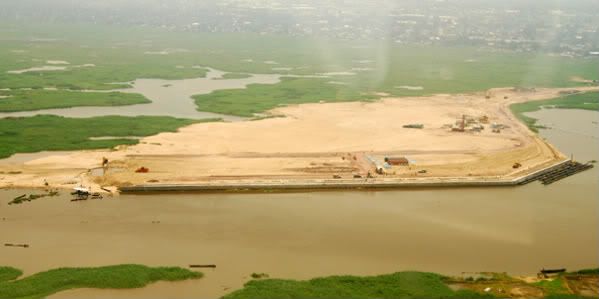

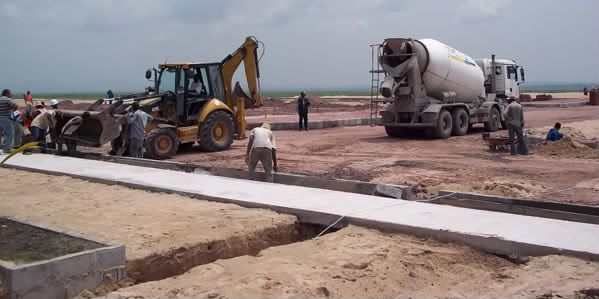









So they going turn Cape Verde into a gambling mecca off the coast of Africa.

Madagascar: Empowering Malagasy Women Through Climate-Smart Raffia Production
Tagged:
18 AUGUST 2015
PRESS RELEASE
Support for women's associations in Madagascar to enhance raffia production is also helping the conservation of biodiversity in the Makira Natural Park.
In 2015, the International Trace Centre's (ITC) Trade and Environment Programme in collaboration with the Wildlife Conservation Society (WCS) launched a two-year project in Madagascar to improve and develop the raffia-palm value chain for the international handicraft and fashion industries.
The aim of the initiative is to enhance women's economic empowerment and strengthen the climate resilience of Madagascar's raffia sector.
Leaves from Madagascar's raffia palms are widely used as a high-quality natural input for products made by local communities and international companies, including basic woven goods and high-end luxury products.
International fashion houses have expressed interest in sourcing a sustainable supply of raffia from women's associations based around Madagascar's Makira Natural Park, which have a long history of raffia production for local markets.
Raffia value addition
Raffia harvesting, sorting, and processing are carried out manually, and often by local groups or associations who sell directly to brands or retailers.
Support to increase the quality and business capacity of these associations and linking them to international markets through trade fairs and workshops will increase their bargaining position and the income they receive from their products.
However, raffia in the Makira Natural Park has been affected by climate change: frequent droughts are threatening to up raffia forests. To help tackle this, ITC and WCS are providing assistance for climate-change adaptation to secure stable incomes from raffia in the long term.
The interest in sourcing raffia from Makira is not only because of the high quality found in this area, but also the added benefits from enhanced biodiversity conservation.
WCS is the delegated manager of the 372,000-hectar park, which contains over 20 lemur species and the largest remaining area of low to mid-elevation tropical forest in the Madagascar.
The project will provide households around the park with increased income and aims to reduce their dependence on unsustainable exploitation of natural resources. Households engaged in the project will also be involved in conservation activities in Makira Natural Park as part of their responsibilities and collaborative managers of the Park.
Training of trainer workshops
During the months of July and August 2015, ITC and WCS have been offering training workshops for around 200 women from six women associations in the Makira forest.
The women have been trained on raffia harvesting, sorting, drying, tanning, processing techniques to improve product quality, the creation and design of final products as well as on planting techniques of the raffia trees to ensure climate resilience and long-term profitability.
The capacity building sessions are implemented in two stages. First, 24 representatives - four women from each woman's associations - participated in a 'training-of-trainer' workshop to enable them to train other members of their associations in the long-run.
In the upcoming weeks, 180 members of the women associations will successively receive one week training sessions. In 2016, the women associations will receive trainings on contract negotiations and organization of their associations, thus increasing their business capacity.
Manuals, training modules and posters were prepared in Malagasy and French and will form a base for replicating the project in other regions of Madagascar.
The raffia project is intertwined with to a broader programme ITC is developing in Madagascar, which focuses on promoting exports of natural resources to provide direct benefit to rural livelihoods and encourage conservation of biodiversity. This broader programme is supported by the Ministry of Trade and Consumption, and the Ministry of Environment of Madagascar.
Learn more about ITC's Trade and Environment Programme.

Botswana welcomes proposal to help Seychelles to train more of its teachers
Victoria, Seychelles | August 19, 2015, Wednesday @ 19:03 in National » GENERAL | By: Rassin Vannier and Sandra Barbier | Views: 512
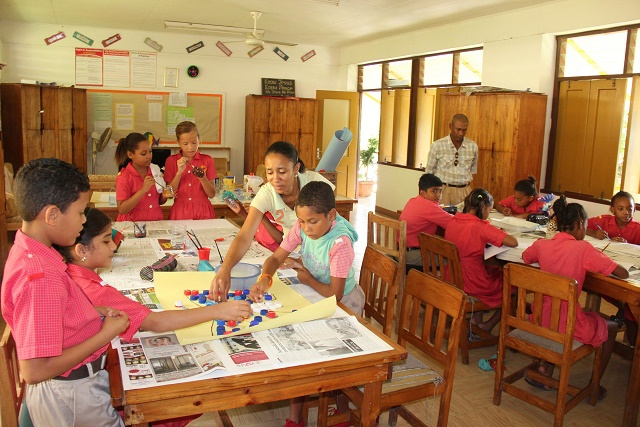
Seychelles should receive help from Botswana teachers to fill the shortage of teachers in the school system. (Joena Bonnelame, Seychelles News Agency)
(Seychelles News Agency) - A group of teachers from Botswana are expected to come to the Seychelles by December this year, to fill the shortage of teachers in the various schools of the island ocean island nation.
According to a press statement from State House, this agreement follows a meeting between the Vice President of Seychelles, Danny Faure, with the Minister of Education and Skills Development of Botswana, Unity Dow.
This meeting took place on the sidelines of SADC’s 35th annual summit held on the 17th and 18th of August in Gaborone, Botswana, where Vice President Faure was representing President James Michel.
According to the statement, "this meeting was held to propose an exchange program with the Botswana authorities in order to secure placement for a backlog of Seychellois teachers currently awaiting to complete their advance studies in various fields of teaching…..without compromising the number of teachers available to fulfill the human resource requirements in the immediate."
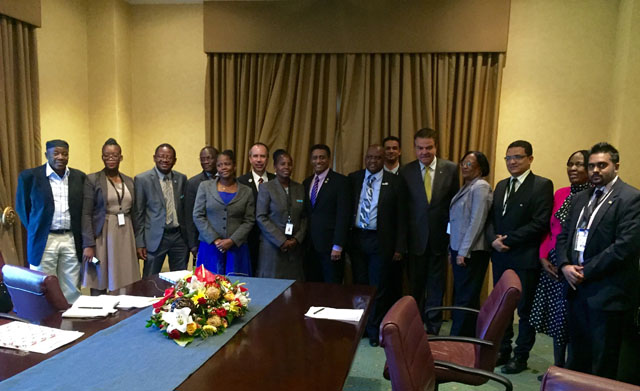
Vice President Danny Faure of the Seychelles initiated a sideline meeting with the Minister of Education and skills development of Botswana, Unity Dow ( State House) Photo License: CC-BY
Vice President Faure proposed an exchange programme for the placement of Seychellois students at the University of Botswana, and in return the Seychelles would be willing to consider employing teachers from Botswana. Both countries use English as a language of teaching.
This would also help to fill the immediate gap of the trainee teachers who will be sent abroad.
The Botswana authorities have on their part welcomed the proposal while stressing on the fact that the university has the capacity to absorb additional students from Seychelles.
They further added that they have currently a surplus of qualified teachers who can benefit from the recruitment programme and therefore allow both parties to benefit from the agreement.
Seychelles and Botswana have had close cooperation in the education sector in recent years. A number of Seychellois students have in the past undertaken training in Botswana, particularly in the field of librarianship.
"Currently, there are 20 Seychellois already following first degree courses in the Botswana University in the area of English language, mathematics, sciences and social sciences," reads the press statement.
The agreement on the exchange progamme still needs to be formalised with the signature of a memorandum of understanding in the coming months.
The first cohort of Botswana teachers are expected to arrive in the Seychelles by mid December 2015, and the group of Seychellois teachers are expected to start their studies in Botswana in January 2016.
Seychelles, an island nation of 90,000 inhabitants, has many foreign teachers working in the state schools of the country as well as in the private sector, among which many come from Sri Lanka, India and Kenya.

Zambia flags off first export of coffee to Japan
August 19, 2015
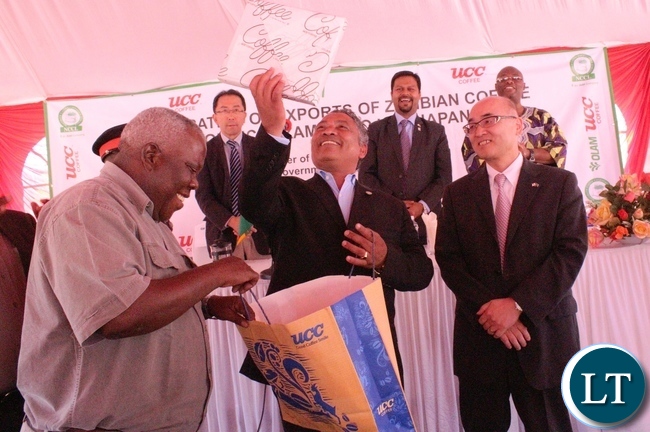
Minister of Agriculture Given Lubinda listens with UCCI Representative Tetsuya Seki after the inauguration ceremony of the shipping of the coffee beans to Japan produced by Olam Limited today. Looking on is northern Province Minister Freedom Sikazwe. Picture by Mary Bwembya.
Agriculture Minister Given Lubinda has officially flagged off the first ever export of Zambian coffee to Japan.
ZANIS reports that Mr Lubinda launched the shipment of the coffee beans produced by Northern Coffee Cooperation limited plantation to UCC coffee of Japan in Kasama today.
And Mr Lubinda said the export of Kasama coffee to Japan marks the revival of the coffee industry in the country.
He said the development also provides an opportunity to market Zambian coffee on the international market.
The Agriculture Minister urged the business community to consider investing in the coffee industry.
Mr Lubinda said his government will continue to support the growth of the industry by creating an enabling environment.
Earlier, Japanese Ambassador to Zambia Kiyoshi Koinuma said Japan seeks to strengthen the bilateral relationship with Zambia through enhancement of trade and investment in various sectors.
And Mwinelubemba, Chitimukulu Kanyanta Manga II praised Northern Coffee Cooperation Limited for the investment which he said will help to reduce poverty and unemployment.
The Mwinelubemba has since pledged to allocate land for a coffee out grower scheme for the company.
He said such investments should be encouraged by all stakeholders.
Northern Coffee Cooperation Limited, a subsidiary of OLAM limited has been in operation since 2012.
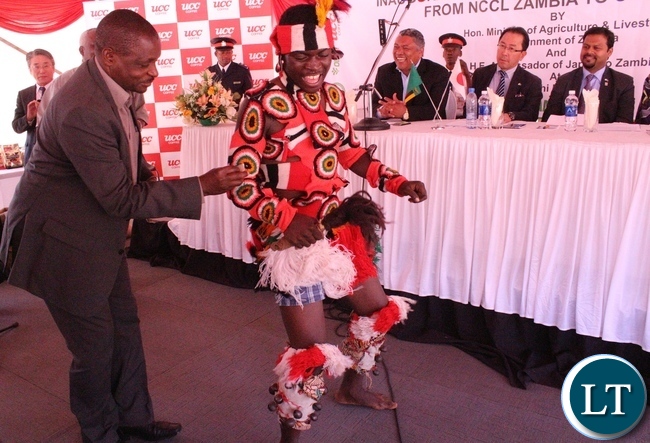

Deputy Minister of Agriculture Maxas Ng'onga at the inauguration ceremony of the shipping of the coffee beans to Japan produced by Olam Limited today. Looking on is Agriculture Minister Given Lubinda, Japanese Ambassador to Zambia Kiyoshi Koinuma, and NCCL Varun Mahajan. Picture by Mary Bwembya.
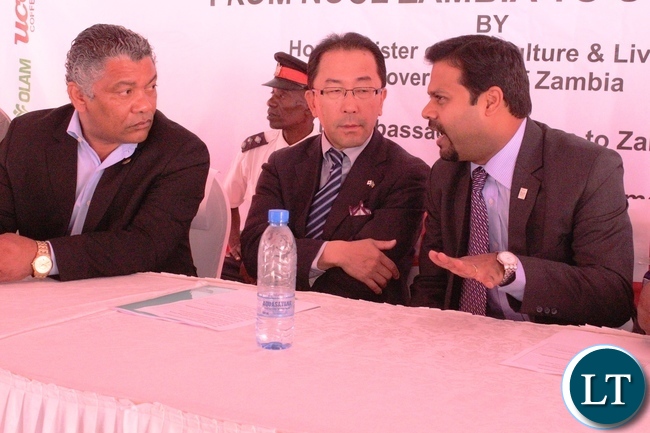
Mwinelubemba Chitimukulu Kanyanta Manga II being welcomed by Japanese Ambassador to Zambia Kiyoshi Koinuma at the inauguration ceremony of the shipping of the coffee beans to Japan produced by Olam Limited today. Looking on is Agriculture Minister Given Lubinda and Northern Province Finister Freedom Sikazwe. Picture by Mary Bwembya.
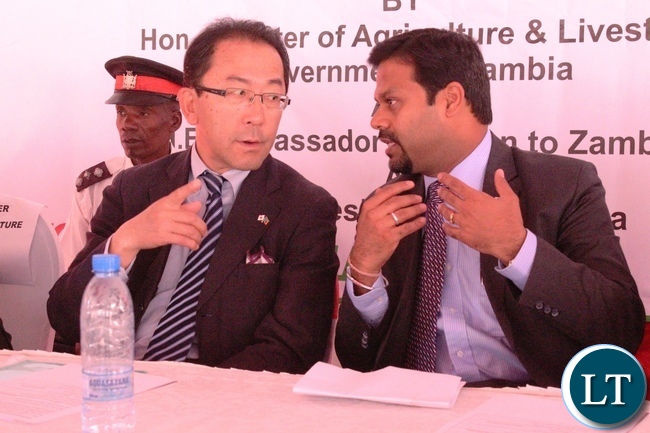
Japanese Ambassador to Zambia Kiyoshi Koinuma with NCCL Varun Mahajan at the inauguration ceremony of the shipping of the coffee beans to Japan produced by Olam Limited today. The event was also attended by Agriculture Minister Given Lubinda.
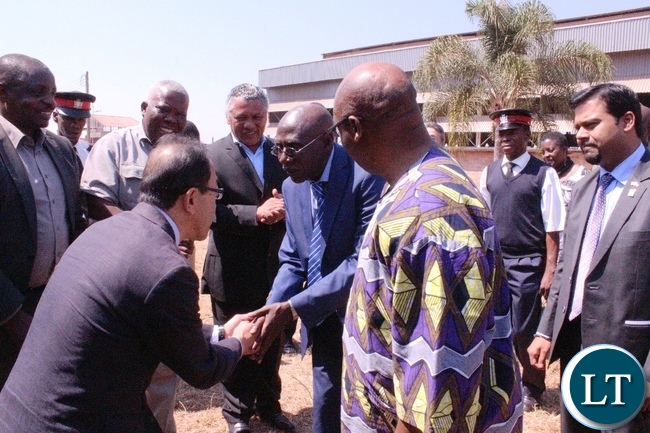
Mwinelubemba Chitimukulu Kanyanta Manga II being welcomed by Japanese Ambassador to Zambia Kiyoshi Koinuma at the inauguration ceremony of the shipping of the coffee beans to Japan produced by Olam Limited today. Looking on is Agriculture Minister Given Lubinda and Northern Province Finister Freedom Sikazwe. Picture by Mary Bwembya.
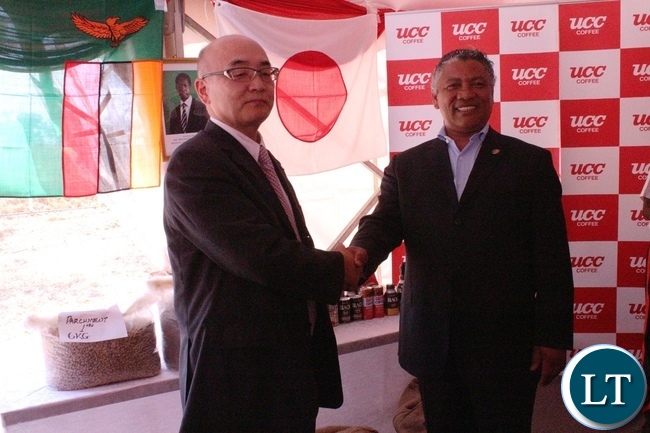
Minister of Agriculture Given Lubinda pose for a photo with UCCI Representative Tetsuya Seki after the inauguration ceremony of the shipping of the coffee beans to Japan produced by Olam Limited today. The colorful event was also attended by Japanese Ambassador to Zambia Kiyoshi Koinuma, NCCL Varun Mahajan and Mwinelubemba Chitimukulu Kanyanta Manga II. Picture by Mary Bwembya.
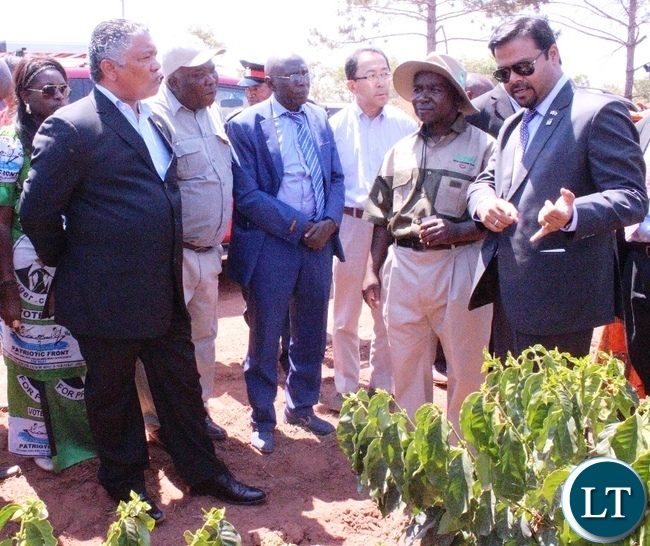
Minister of Agriculture Given Lubinda listens to NCCL Representative Varun Mahajan when he toured Olam plantation today. Looking on is Japanese Ambassador to Zambia Kiyoshi Koinuma, UCCI Representative Tetsuya Seki and Mwinelubemba Chitimukulu Kanyanta Manga after the inauguration ceremony of the shipping of the coffee beans to Japan produced by Olam Limited.

Republic of Mauritius- News
21 AUGUST 2015
Mauritius: Some 1,056 Families to Become Owners of the Plot of Land Which They Are Occupying
Tagged:
PRESS RELEASE
Some 1,056 families holding building site lease over plots of State Land will soon obtain their letter of intent from the Ministry of Housing and Lands to allow them to become owners of the plot of land which they are occupying.
The Vice-Prime Minister, Minister of Housing and Lands, Mr Showkutally Soodhun, made the announcement at a press conference yesterday in Port Louis. According to Mr Soodhun, his Ministry has initiated procedures to enable these families holding building site lease over plots of State Land of 70 to 100 toises and over which stands their residential unit, to purchase the plot at a nominal price of Rs 2,000.
The situation of squatters across the country was also one of the main themes of the press conference. Regarding some 443 cases of residential squatting over State Land in Port Louis, the Vice-Prime Minister stated that soon there will not be any squatter in the Port Louis region. "While some squatters are being relocated in Pointe aux Sables and Batterie Cassée, others will be regularised 'in situ," he said. For the squatters of La Ferme and Eau Bonne, the Vice-Prime Minister affirmed that following talks with Medine Ltd, the latter has agreed to identify plots of land which it would put at the disposal of Government for these families.
The Vice-Prime Minister also stressed that a solution has been found regarding around 400 families who have been living for the past fifty years on a 'Camp Sucrier' (old sugar estate) in the Moka Regions without any deed or land contract. He added that the issue will be presented soon to Cabinet to start the necessary procedures to enable these families to obtain their deed. Recalling that the lack of deed led these families to face several practical constraints, Mr Soodhun said that the Government had discussed the matter with ENL Ltd in view of finding adequate solution.
As for the National Housing Development Company Ltd (NHDC) housing units, the Minister said that 3,000 units will be delivered by June 2016. "In that context, three Smart Residences, the latest NHDC housing estate designed and developed in an integrated manner, will be inaugurated in Camp de Masque and Chebel in September, and in Henrietta, Glen Park, in October," he pointed out. He recalled that all these initiatives are in line with Government's commitment to cater for the vulnerable groups and provide them with adequate decent housing so that they live with dignity.





next 10 years I'm investing HEAVY in african agriculture markets, construction, tech and energy. gonna eat real goodUnlocking Africa’s Trade Potential
WASHINGTON, DC – Africa’s rise challenges the imagination. During the last decade, Sub-Saharan Africa was home to six of the world’s ten fastest-growing economies. During the next five years, the region’s GDP is expected to grow 30% faster than that of the rest of the world. And, during the next 35 years, the continent will account for more than half of the world’s population growth, according to the United Nations.
These trends will give African countries a more prominent role on the world stage, and provide new opportunities for people to better their lives. As African countries assume their new role, they want meaningful economic partnerships that deliver the sustainable, inclusive growth they seek. As US President Barack Obama said during his visit to Ethiopia last month, “Real economic partnerships have to be a good deal for Africa. They have to create jobs and capacity for Africans.”
By those criteria, the African Growth and Opportunity Act (AGOA) has been tremendously effective since its enactment in 2000. By removing tariffs on exports to the United States from 39 Sub-Saharan countries, it has stimulated growth, encouraged economic integration, and created opportunity where it otherwise might not have existed. Earlier this summer, the US Congress, recognizing these gains and underscoring the strength of America’s commitment to Africa, overwhelmingly approved legislation to reauthorize AGOA for another ten years.
To make the most of this extension – the longest in the program’s history – the US and its African partners need to start working toward a more comprehensive partnership. That journey begins by acknowledging that tariffs are no longer the biggest constraint on trade in Africa. Today, the chief impediments are supply-side constraints, which require well-designed strategies and capacity-building efforts so that AGOA’s members can take full advantage of the program’s benefits.
Making the most of AGOA will also require improvement in the infrastructure – physical and institutional – necessary for promoting investment and facilitating trade. The issues that need to be addressed include the lack of reliable, affordable electricity, high transportation costs, and weak and inefficient trade-related facilities.
Consider the challenges faced by Brazzaville, in Congo, and Kinshasa, in the neighboring Democratic Republic of Congo. These two cities, separated by the Congo River, are expected to grow to a combined total of nearly 20 million residents by 2025. But, because of poor infrastructure and inefficient customs procedures, only 1.1% of Congo’s imports come from its neighbor.
According to the World Bank, getting a container across the Congo River costs almost $4,500, and the total can top $10,000 once the cost of inland transportation is added. By contrast, moving an identical container with the same cargo from Malaysia to Singapore costs less than $1,000.
Africa needs to build its capacity to trade competitively in today’s global economy. That is why the Office of the US Trade Representative, the Millennium Challenge Corporation (MCC), USAID, and other US government agencies are advancing programs like Trade Africa, Power Africa, and Feed the Future to help the continent develop sustainable infrastructure and increase regional integration.
Consider MCC’s work in Benin. As one of the US agencies leading efforts to build trade capacity in Africa, MCC committed more than $180 million to upgrade the Port of Cotonou, which serves as a gateway for trade not only to Benin, but also to the landlocked countries of Burkina Faso, Mali, and Niger. MCC’s investment, which leveraged public and private funds, aimed to alleviate chronic freight bottlenecks in the port by doubling its capacity to import and export cargo.
During President Obama’s visit to Africa, MCC made a further commitment of $52 million to support a series of similar public-private partnerships that are expected to generate $750 million in investments in Africa. MCC could do even more to increase trade capacity and cross-border engagement if it had the authority to pursue regional investments. By investing in cross-border roads or power transmission, for example, MCC could help increase economic activity and promote regional integration.
Such efforts would help African and American exporters alike, including the 120,000 Americans whose jobs are supported by US exports to sub-Saharan Africa. That is why leaders in Congress from both parties are working to give MCC this much-needed authority.
Even as we consider how to make the most of AGOA’s historic renewal, we need to look beyond 2025 and imagine what a deeper, more mature economic partnership might entail. Of course, we will need to account for emerging economic realities both within and outside of Africa. Already, many African countries are forging more permanent, reciprocal relationships with other developed-country trading partners.
At the same time, the US is moving forward with next-generation trade agreements – the Trans-Pacific Partnership and the Trans-Atlantic Trade and Investment Partnership – that will raise standards across both the Asia-Pacific region and the Atlantic and will have positive spillover effects in Africa. For example, the TPP will help combat illegal wildlife trafficking, including illegal trade in ivory from Africa. In other areas, including labor rights, these agreements could help make higher standards the global norm.
As President Obama made clear at the US-Africa Leaders Summit in Washington, DC, a year ago, the US is not new to Africa. Indeed, we have been engaged in Africa for decades, not as a colonial power, but as a partner. And that partnership is based not just on extracting resources from the region, but on unlocking growth for all. As representatives from across Africa gather in Libreville, Gabon, this week for this year’s AGOA Forum, we have an opportunity and an obligation to take that partnership to the next level.
Read more at Unlocking Africa’s Trade Potential


